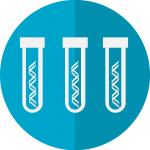SomnusNooze
 Dr. Ana Krieger
Dr. Ana Krieger
Although the Hypersomnia Foundation is not currently accepting new submissions for its Ask the Doctor series, we are working to answer previously submitted questions that are of general interest to our hypersomnia community. Today we have Dr. Ana Krieger of Weill Cornell Medical College, a distinguished member of our Medical Advisory Board, who is board certified in sleep medicine, pulmonary medicine, and internal medicine, to answer two questions about IH – whether it has a genetic component and whether it can go into remittance.
QUESTION #1:
Is there a genetic origin in idiopathic hypersomnia, like in narcolepsy?
RESPONSE:
It is common (approximately 33%) for IH patients to have a family member with similar symptoms; therefore, researchers believe that IH likely has a substantial genetic component, but the details are not yet known.1,2,3,4 As of now, there is no genetic testing that can predict the risk of developing IH or identify protective traits. With advances in technology for genomic analyses, it is quite likely that genetic testing for IH will be developed in the future. However, the key for such studies is the availability of a well-characterized group of people who share the same condition. The Hypersomnia Foundation’s registry at CoRDS is opening the door for further genetic studies. The accuracy in reporting information from as many patients as possible will be critical in making these studies possible.
QUESTION #2:
I’ve read that IH can spontaneously remit in 10-15% of people, but I find this hard to believe. Where does this number come from?
RESPONSE:
A 2007 retrospective study comparing the characteristics of patients with idiopathic hypersomnia and narcolepsy reported a remission rate of 10% in the IH cases.1 Two other studies found higher remission rates of 25%3 and 33%.5 However, as the name implies, underlying causes of IH are still unclear, and it is possible that some or all patients who experienced remission might have had other conditions with similar symptoms of excessive daytime sleepiness (Kleine-Levin syndrome or mononucleosis for example) instead of IH. Given the current difficulty of accurately diagnosing IH, these reported remission rates should not necessarily be viewed as clinically relevant data.
At this time, there are no conclusive tests for diagnosing IH, and there is no known cure for IH. One of the goals of the Hypersomnia Foundation is to continue to expand its registry of patients to allow for the characterization of IH on a larger scale and to foster collaborative research in order to identify the most common disease pathways and help develop therapeutic targets for symptomatic control.
Please help support this goal by donating now, and if you have IH or a related disorder, please join our registry at CoRDS now (or ensure your responses are updated)!
 References:
References:
- Anderson K.N., Pilsworth S., Sharples L.D., et al: Idiopathic Hypersomnia: A Study of 77 Cases. Sleep 2007; 30: pp. 1274-1281
- Ali M., Auger R.R., Slocumb N.L., et al: Idiopathic hypersomnia: clinical features and response to treatment. J Clin Sleep Med 2009; 5: pp. 562-568
- Bassetti C., and Aldrich M.S.: Idiopathic hypersomnia. A series of 42 patients. Brain 1997; 120: pp. 1423-1435
- Vernet C., Leu-Semenescu S., Buzare M.A., et al: Subjective symptoms in idiopathic hypersomnia: beyond excessive sleepiness. J Sleep Res 2010; 19: pp. 525-534
- Kim T., Lee J.H., Lee C.S., et al: Different fates of excessive daytime sleepiness: survival analysis for remission. Acta Neurol Scand 2016; 134: pp. 35-41
Disclaimer for Ask The Doctor: The medical information provided is meant for educational purposes only and is not a substitute for professional medical care and advice. Each person is different, and questions about a personal health condition should be discussed with your own healthcare professional.
